Lamplight City Review
Solve crimes, communicate with a jabbering ghost, give your gray matter a workout and have fun!
Lamplight City by Grundislav Games, aka indie developer Francisco Gonzalez (Shardlight, A Golden Wake), is a clever game. It has witty dialog, well-drawn characters, great music, beautiful pixel art, wonderful voice acting and a keen sense of humor. But before I get into the game itself, let’s have…
An English Lesson
I’m a big fan of the English language. What struck me immediately about Lamplight City is its use of words and phrases from eras past. This impressed me more than all get-out. All are appropriate, as the game takes place in the mid-1800s. These are among the ones I encountered; definitions are included:
Gaol – this is an alternate spelling of jail. Both words are pronounced identically and mean the same thing. From Old French (jaiole) and Anglo-Norman French (gayole). Until the 17th Century, pronounced with a hard “g.”
Soporific – a sleep-inducing substance, from the Latin sopor. First used in the 17th Century.
Inhumation – also from the 17th Century. Being buried in the ground rather than cremated. From the Latin inhumare.
Fainting Couch – originating in the Victorian Era, this kind of couch has a headrest at one end and was designed to accommodate those who fainted — primarily women. (That figures.)
Écarté – a card game that originated between 1815-1825.
Okay, class dismissed!
Story
Lamplight City takes place in a fictional steampunk port city called New Bretagne, in an alternate Victorian Era. You will visit each of its four boroughs — Cholmondeley (easier said than spelled), Lyon, Worcester and Gascogne — during the course of the game. There’s plenty to do in each location.
The player-character is police detective Miles Fordham. He’s a flawed protagonist — my favorite kind. In the prologue his partner, Bill Leger, is killed while the two are investigating a crime.
Miles blames himself for Bill’s death, quits the force and becomes a private investigator. He starts drinking too much and ingesting too much soporific. His appearance becomes chronically disheveled — my favorite look. The killer is still at large.
In a plot point somewhat reminiscent of Wadjet Eye’s Blackwell series, Bill’s ghost sticks around. He can’t be seen — not even by Miles — but becomes, instead, a voice in Miles’ head.
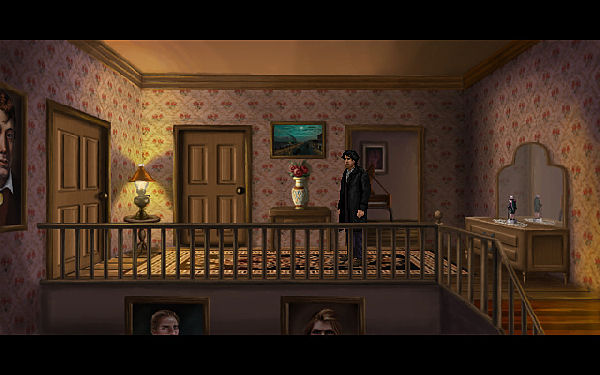
Bill goes everywhere with Miles, providing a running commentary on whatever Miles is doing. He injects quips and wisecracks (some of which are genuinely laugh-out-loud funny); he insults, harasses and nags Miles (in a friendly way, of course); makes suggestions (some good, some not so much) and keeps prodding Miles to find his killer. He never shuts up, even when Miles is trying to sleep. Hence, the aforementioned soporific.
Miles has told no one — not even his wife — that he hears Bill’s voice. He’s afraid people will think he’s crazy. Instead, he guzzles booze and sleeping potions, lies to his wife (who knows something is very wrong) and seems to be losing his grip. He sometimes talks to Bill within earshot of others. They can’t hear Bill but they can sure hear Miles. When asked about this, he tells people he’s been talking to himself. I guess he doesn’t realize that such behavior could also be interpreted as crazy.
I love this guy. He’s a mess!
Miles is fed cases on the sly — there are five altogether — by a friend in the police department. All five did a good job of holding my interest. They involve such things as premature burial, kidnapping, spontaneous human combustion (my favorite), sabotage and serial killings. All are well-written; all yield multiple suspects.
Lamplight City has a healthy sense of humor. Of particular note is when Miles is trying to get some info from a lawyer who’s not cooperating. It’s one of the funniest exchanges I’ve come across in a game, adventure or otherwise.
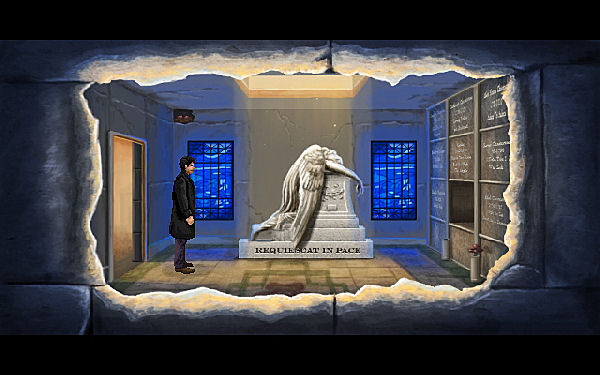
The game is set against a backdrop of political intrigue; industrial progress and emerging steam technology (with related mishaps); fears that machines will replace people; militant radicals who blow things up; and the divide between the haves and have-nots — with a little marital discord thrown in. All cases are interconnected through an overarching plotline.
Miles must confront all of this with Bill chattering away in his head. Miles has genuine affection for Bill, but Bill is driving him nuts. He tells Bill to shut up, but Bill just keeps on talking. (I’m glad he does, too. He has a majority of the funny dialog!)
Each case has two — and potentially several — endings. Some are more gratifying than others (more about that shortly). This definitely enhances replay value.
Mechanics
Lamplight City was constructed using Adventure Game Studio. Navigation is standard point-and-click. In a break from the usual adventure game elements, there is no inventory. You do pick up a few things, but they’re stored as text descriptions in Miles’ Casebook. Miles simply uses them automatically when you arrive at the correct spot.

There are also puzzles to solve. But primarily, Lamplight City consists of talking to people and using their replies to formulate suspects. The game boasts over 50 interactive characters. Identifying the guilty party isn’t always easy, as the game can give you false leads and throw red herrings in your path.
Each case has its own ending. Rather than being pushed along to a predetermined outcome, players are made active participants in the crime-solving process. In order to successfully negotiate Lamplight City, you must pay attention and make decisions that will drive the narrative and hopefully reveal the culprit. If you get things wrong, your investigations can become difficult. If you reach a stalemate, declaring the case unsolvable will advance you to the next one.
What you do during the course of the game can have an impact on how you’re perceived in remaining cases. It’s possible to alienate characters to such an extent that they’ll refuse to speak with you further (or, in some cases, at all). Identifying the wrong person as the guilty party can represent a major blunder.
The aforementioned Casebook helps keep track of things; nevertheless, I took ten pages of notes. A map that reflects all four boroughs lets you jump from one location to another.
I played Lamplight City from start to finish three times. The first time, my choices resulted in the game ending rather abruptly with an unsatisfying resolution. After mumbling unkind things under my breath, I realized I must have missed some important things on my way through the game, but was permitted to finish it anyway. How deviously inventive! I knew there had to be more to the game than what I’d seen.
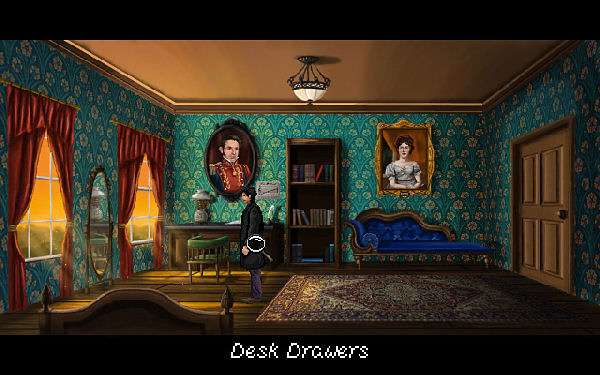
I conducted my second playthrough more carefully, which led to a more palatable ending. I also discovered that I had, indeed, missed more than a few things the first time around. This also demonstrated the degree to which my choices could influence the proceedings.
I decided to do a third playthrough, as I’d become more familiar with the way the game works and wanted to see if I could do things differently and still reach a satisfying ending. This gave me a greater appreciation of the skill it took to put Lamplight City together, and allowed me to advance through the game more smoothly.
Graphics
The game is presented in pixel graphics, which routinely do a number on my eyes. Not so in this game: characters aren’t exceedingly ragged around the edges. As screenshots demonstrate, they’re relatively smooth, nicely rendered and quite colorful. My eyes didn’t complain once.
When Miles questions someone, he and that person appear as polished, detailed portraits à la Gabriel Knight. I appreciated being able to see close-ups of the characters. Some of them look rather bizarre! And seeing flawed, scruffy-looking Miles was always a pleasure.
Characters, Voice Acting and Music
I love this game’s main characters and actually became attached to them. You’ve already been introduced to Miles. You don’t see much of Bill — he’s dead, after all — but you sure do hear him. Adelaide is Miles’ sensible but put-upon wife, and Constance Upton, who is refreshingly frumpy-looking, is Miles’ PD contact.
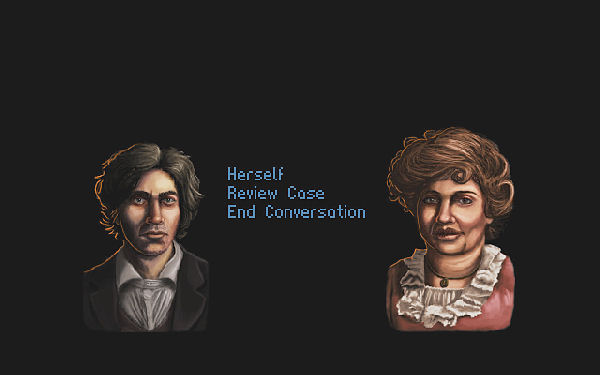
The voice work for these characters is outstanding, with Ben Britton as Miles, Al Pagano as Bill, Felicia Hudson as Adelaide and Miranda Gauvin as Upton. Each delivers dialog convincingly, in a way that befits his or her character.
The music in Lamplight City, by composer Mark Benis, is brilliant. It’s of cinematic quality and enhances the game’s atmosphere wonderfully without being overbearing. The OST is available for purchase on Steam. Mark also lends his voice to the game.
I’m a Detective…it’s What I Do
By playing the game more than once I discovered a few things, such as…
At least one puzzle is random.
Characters you need to talk to can appear at different locations, depending on the path you’ve taken to reach them.
In the game’s coffeehouses, you can stand near characters who are chatting and hear what they’re saying. No one says anything crucial; it’s just fun to eavesdrop.
If a destination is not reflected on the map and you feel it should be, you might have missed its trigger. Try clicking/viewing/reading everything in your Casebook. This saved me some hair-pulling more than once.
Concluding Remarks
Finishing Lamplight City will unlock bonus content, including bloopers and concept art. The game is fairly lengthy. I’d say a single playthrough might take 10-15 hours. Based on my experience, however, I recommend playing the game more than once. I feel it can be easy to overlook things the first time out and end up with a disappointing ending.
In my case, a second playthrough took my opinion from “meh” to “yeah” (how could I have missed all that stuff?). Playing it a third time resulted in true love. I give Lamplight City my wholehearted recommendation. Just remember: pay attention and keep your brain turned on!
Grade: A
|
+ Well-drawn characters with a wonderfully flawed protagonist
+ Five diverse, well-written cases
+ A healthy sense of humor
+ Great voice acting, graphics and music
+ Appropriately uses terminology from eras past
– Can have unsatisfactory ending if too much is missed during playthrough
– To get the most from the game, several playthroughs are recommended; this may not be to everyone’s liking
|
 |
Processor: Pentium or higher
Memory: 1 GB RAM
Graphics: 640×400, 32-bit colour
DirectX: Version 5.2
Storage: 2 GB available space
Sound Card: All DirectX-compatible sound cards
Processor: 1.2 GHz
Storage: 2 GB available space
Processor: Pentium or higher 1.2 GHz
Memory: 1 GB RAM
Graphics: 640×400, 32-bit colour
Storage: 2 GB available space

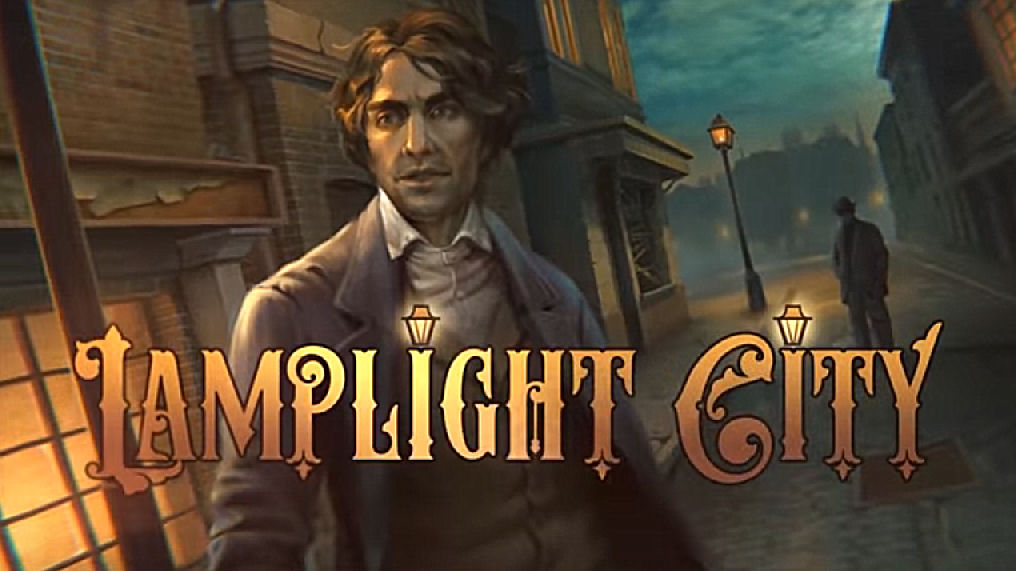
Leave a Reply